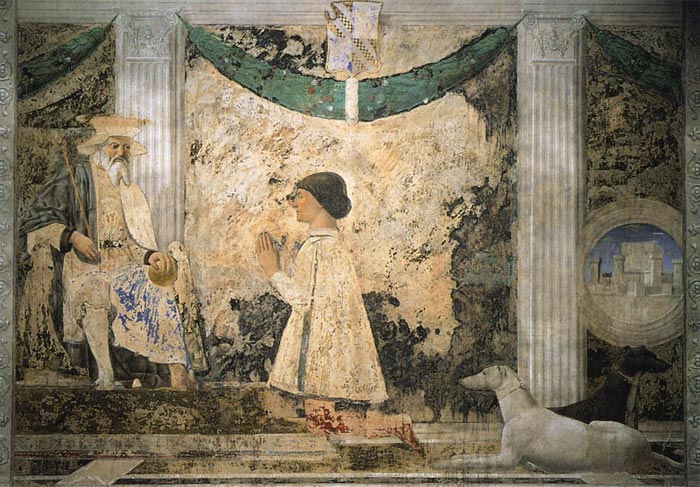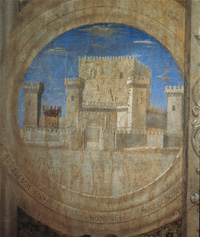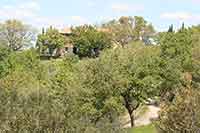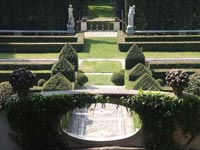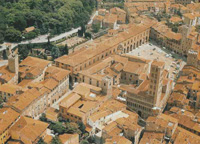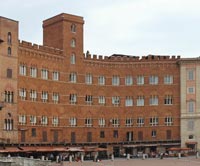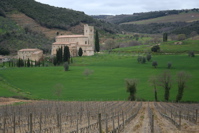| |
|

[1] The Italian Renaissance is best known for its cultural achievements. Accounts of Renaissance literature usually begin with Petrarch (best known for the elegantly polished vernacular sonnet sequence of the Canzoniere and for the craze for book collecting that he initiated) and his friend and contemporary Boccaccio (author of the Decameron). Famous vernacular poets of the 15th century include the renaissance epic authors Luigi Pulci (author of Morgante), Matteo Maria Boiardo (Orlando Innamorato), and Ludovico Ariosto (Orlando Furioso). 15th century writers such as the poet Poliziano and the Platonist philosopher Marsilio Ficino made extensive translations from both Latin and Greek. In the early 16th century, Castiglione (The Book of the Courtier) laid out his vision of the ideal gentleman and lady, while Machiavelli cast a jaundiced eye on "la verità effettuale della cosa"—the actual truth of things—in The Prince, composed, humanist style, chiefly of parallel ancient and modern examples of Virtù. Italian Renaissance painting exercised a dominant influence on subsequent European painting (see Western painting) for centuries afterwards, with artists such as Giotto di Bondone, Masaccio, Piero della Francesca, Domenico Ghirlandaio, Perugino, Michelangelo, Raphael, Botticelli, Leonardo da Vinci, and Titian. The same is true for architecture, as practiced by Brunelleschi, Leone Alberti, Andrea Palladio, and Bramante. Their works include Florence Cathedral, St. Peter's Basilica in Rome, and the Tempio Malatestiano in Rimini (to name a only a few, not to mention many splended private residences: see Renaissance architecture). Finally, the Aldine Press, founded by the printer Aldo Manuzio, active in Venice, developed Italic type and the small, relatively portable and inexpensive printed book that could be carried in one's pocket, as well as being the first to publish editions of books in Ancient Greek. Yet cultural contributions notwithstanding, some present-day historians also see the era as one of the beginning of economic regression for Italy ( there were some economic downturns due to the opening up of the Atlantic trade routes and repeated foreign invasions and interference by both France and the Spanish Empire).
Art in Tuscany | Art during the Italian Renaissance
|


Holiday accomodation in Tuscany | Podere Santa Pia | Artist and writer's residency
|
| |
|
|
|
|

. |
|
|
Podere Santa Pia |
|
Podere Santa Pia, garden view, April |
|
View from Podere Santa Pia
on the coast and Corsica |
| |
|
|
|
|
|
|
|
|
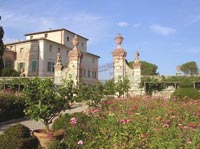
|
Villa I Tatti |
|
Arezzo |
|
|
|
|
|
|
|
Siena, Palazzo Sansedoni |
|
Abbey of Sant 'Antimo |
|
Siena, duomo |
| |
|
|
|
|
The Powerful Families of Renaissance Italy
|
At the time of the Borgia papacy, Italy was ruled by several types of government: territorial overlords called signore, marquises, dukes, and kings - as in the case of Naples (Venice was an oligarchial republic ruled by a military duke, called the Doge). Some of these princes were technically papal vassals - hereditary rulers who received the rights to own and inherit immovable property and revenue. They "owned" their lands under two major conditions: 1. They must send annual tribute to the granter, and 2. They must defend and protect the interest of the granter.
The Kingdom of Italy, when it was a satellite of the Holy Roman Empire under Frederick I (Barbarossa), was ruled by imperial vassals who held northern Italian lands in fief for the Holy Roman Emperor. Gradual changes in the makeup of the Holy Roman Empire led to the deterioration of its control in much of northern and central Italy. Some of these lords and princes gradually asserted their authority and maintained their independence from the Empire. At the same time, they were alternately free, papal, and conquered realms until the Italian Wars (1494-1550s) and later Unification of Italy (1850s).
Many important cities in Renaissance Italy were ruled by hereditary noble families, elites in control of independent communes, republics, and former imperial fiefs that were at war with one another throughout of the 13th and 14th centuries. The borders of 1492 Italy were continually being shaped by some of these powerful ruling dynasties.
Two of the most famous, or infamous, Renaissance ruling families were the Medici family of Florence and the Borgia family of Rome. Perhaps less well-known and less powerful than the Medici, the Borgia family has an even more sinister reputation. They are remembered as much for their treachery as for their political accomplishments. The head of the family, Rodrigo Borgia (1431-1503), became Pope Alexander VI in 1492, an office he held until his death in 1503. Although Alexander supposedly died from malaria in 1503 at the age of seventy-two, rumors circulate even now that he met his end after mistakenly eating a piece of poisoned fruit intended for one of his guests.
|
At the time of the Borgia Papacy, the Este ruled the cities and lands of Ferrara, Modena, and Reggio. The Sforza ruled Milan, Pavia, Pesaro, and Caravaggio. The Medici were de facto rulers of Florence and Pisa up until 1492, when they were expelled. The Republic of Florence reverted to rule by the Signoria from 1494-1502. Piero Soderini was elected Gonfaloniere, and effectively ruled Florence until 1512 with the return of the Medici. The Gonzaga ruled Mantua and the Montefeltro ruled Urbino - both families asserted near total independence by 1400. The Kings of Naples descend from Alfonso V the Magnanimous, (brother of King John II of Aragon). The House of Aragon, used as a surname here, will indicate the rulers of Naples and Sicily between 1442 and 1499. The Orsini and Colonna ruled several cities and controlled several fortresses in and around Rome. The Bentivoglio ruled Bologna until 1506. The Baglioni were papal vicars who ruled Perugia, as were the Malatesta of Rimini. The Petrucci of Siena were nobles of the Republic and after 1487 ousted the signoria and ruled as independent lords, much like the Medici of Florence.
|
The Este Family of Ferrara
|
The noble Este Family ruled Ferrara and Modena as vicars of the Holy Roman Empire, whom gradually asserted and protected their independence from the Empire. The Este were culturally refined, wise and capable rulers, and revered by their subjects.
The most famous member of the House of Este is Isabella d'Este, Marchesa of Mantua. She married Francesco II Gonzaga, a powerful condottiero and ruler of a mostly independent city-state in Lombardy. She was known to be a capable diplomat and firm ruler during her husbands many long absences.
Even this highly culturedRenaissance family had their share of brutal inter-family rivalries and murders. In 1505, Lucrezia Borgia's husband, Duke Alfonso I d'Este was very nearly murdered by his own half-brothers Giulio and Ferrante d'Este. Giulio and Ippolito fell in love with Lucrezia's cousin Angela Borgia. Angela preferred Giulio, and later (for many reasons) Ippolito had assassins stab him in both eyes. They were punished by the Duke Alfonso - leading Giulio and the fourth Este brother Ferrante to plot the murder of Alfonso and usurpation of the throne for Ferrante. They did not succeed. Alfonso imprisoned them in the castle dungeons for the rest of their lives.
Lucrezia's son Ercole II married Renée de France, younger daughter of King Louis XII and Anne of Brittany.
|
The Sforza Family of Milan
|
The noble House of Sforza had relatively humble origins. Their forefathers were rich rural landowners and successful condottieri, whom alternately fought for Milan, Venice, Naples, against Florence and the Pope. Due to Muzio's military capabilities and success in battle, he was later nicknamed "Sforza," (meaning force) and his descendants took his name. Francesco I Sforza married the only heir to the Milanese duchy, Bianca Maria Sforza. After the Visconti's demise, the short-lived Ambrosian Republic ruled Milan through a few years of warfare and internal unrest. Francesco, as captain general of the Milanese army, was given rule of the city by the signoria. He was able to keep ruling the city and its vast territories without papal investiture due to his popularity and success as a ruler.
Francesco and Bianca Maria Visconti had eight children: Galeazzo Maria, Ippolita Maria, Filippo Maria, Sforza Maria, Ludovico Maria, Ascanio Maria, Elisabetta and Ottaviano.
Galeazzo, Duke of Milan in 1466, was assassinated in 1476 (father of Caterina Sforza). Ippolita, married the Duke of Calabria, was a great friend of il Magnifico Lorenzo de Medici. Filippo Maria, Count of Corsica. Sforza Maria, Duke of Bari.Ludivico Maria was later given the Duchy of Bari upon his brother's death in 1479, then was "chosen" as Duke of Milan after his nephew Gian Galeazzo's untimely death. Ascanio Maria was a powerful Cardinal of the Roman Church, Vice-Chancellor of the Curia under Pope Alexander VI.
The Duchy of Milan made up almost all of modern Northwest Italy. It became a subject state of France after it fell during the Italian Wars led by the King of France, Louis XII. It later came under control of the Holy Roman Empire during the reign of Charles V after his victory in the Battle of Pavia.
|
The Medici Family of Florence
|
Members of the merchant-class Medici family of Florence are also called "The Godfathers of the Renaissance." The Medici bank was the most profitable bank in Europe during the Renaissance. The maker of the family fortunes was Giovanni di Bicci de Medici, and his son Cosimo de Medici became the first citizen of the city. He spent 600,000 florins on beautifying Florence and was patron of artists such as Donatello and Fra Lippi. The Medici created a partnership with the Catholic Church. When the Church was split due to the Western Schism, the Medici backed Pope John XXIII and subsequently became the Papal Bankers. Cosimo's grandson, Lorenzo the Magnificent (1449-1492) was a keeper of the peace in Italy, spreading his influence across the Peninsula so that it enjoyed a decade of relative peace. He was also a patron of the arts, with such people as Botticelli, Michelangelo and Leonardo da Vinci flooding his courts.
Pope Leo X (Giovanni de Medici, 1475-1521, Papacy from 1513-1521) was known for his extravagant lifestyle. He once had a boy painted in gold from head to toe parading down the streets of Florence. It was to imply the "return of the Golden Age under Medici Rule" The boy later died as a result of probably lead poison from the gold paint. Pope Clement VII (Giulio de Medici, 1478-1534, Papacy from 1522-1234) took a black slave girl as his mistress. Their child Alessandro became Europe's first black Head of State when he was made Duke of Florence in 1530. Alessandro was assassinated by his cousin Lorenzaccio (Bad Lorenzo) de Medici.
It was under the reign of Leo X that Martin Luther nailed his famous 95 Theses that sparked the growing movement later known as the Protestant Reformation.
The Pazzi family of Florence
About 1429 another wealthy and influential Florentine family, the Pazzi, commissioned Brunelleschi to design a chapel adjacent to the monastic Church of Santa Croce that was intended to be a chapter house (a place of assembly for monks to conduct business).
Pazzi conspiracy, (April 26, 1478), was the unsuccessful plot to overthrow the Medici rulers of Florence; the most dramatic of all political opposition to the Medici family. The conspiracy was led by the rival Pazzi family of Florence.° The conspirators include the Pazzi family (rival bankers), the archbishop of Pisa (a city restless under Florentine control) and a nephew of the pope, Sixtus IV. The pope has recently transferred the papal account from the Medici bank to the Pazzi and would prefer a more docile ruler in Florence. In April 1478 the Pazzi assassinated Lorenzo’s brother Giuliano but failed to kill Lorenzo, and the insurgents, denied support by the citizens, were captured.
In league with the Pazzi were Pope Sixtus IV and his nephew Girolamo Riario, who resented Lorenzo de’ Medici’s efforts to thwart the consolidation of papal rule over the Romagna, a region in north-central Italy, and also the archbishop of Pisa, Francesco Salviati, whom Lorenzo had refused to recognize. An assassination attempt on the Medici brothers was made during mass at the Cathedral of Florence on April 26, 1478. Giuliano de’ Medici was killed by Francesco Pazzi, but Lorenzo was able to defend himself and escaped only slightly wounded. Meanwhile, other conspirators tried to gain control of the government. But the people of Florence rallied to the Medici; the conspirators were ruthlessly pursued and many (including the archbishop of Pisa) were killed on the spot.
The failure of the conspiracy led directly to a two-year war with the papacy that was almost disastrous for Florence. But the most important effect was to strengthen the power of Lorenzo, who not only was rid of his most dangerous enemies but also was shown to have the solid support of the people.
But this is not the end of the crisis. The pope excommunicates Lorenzo de' Medici and persuades the king of Naples, Ferdinand I, to mount an expedition against Florence. During 1479 war drags painfully on, with losses of territory and the expense of maintaining a mercenary army in the field.
|
|
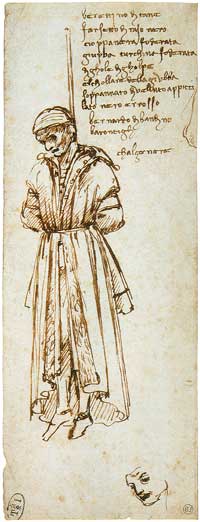
Leonardo da Vinci,drawing of a hanged
Pazzi conspirator Bernardo di Bandino Baroncelli, 1479 |
The Gonzaga Family of Mantua
|
The noble family of Gonzaga ruled Mantua as marquises (Marchesi in Italian), which was one administrative rank below Duke. The first Gonzaga rulers of Mantua were podestas - high ranking government officials - who were later elected as Captains of the People as protectors of the city's defense.
Their 14th century Ghibelline ties to the Holy Roman Empire (as vassals ruling on the behalf of the Emperor) effectively left the city and its territory independent of the major powers in Italy.
The first Marquis, Gian Francesco I and his wife Paola Malatesta, arranged the advantageous marriage of the emperor's niece (some sources list her as his granddaughter) Barbara of Brandenburg to their son Ludovico III Gonzaga.
Their son and successor to the lordship, Federico I married the daughter of Duke Albert III of Bavaria, Margaret of Bavaria. Their children were: Chiara, Francesco II (above at right), Sigismondo, Elisabetta (right), Maddalena, and Giovanni.
Chiara married a Bourbon duke, their son was the famous Charles III, Duke of Bourbon who commanded the imperial troops during the Sack of Rome (1527).
Francesco married Isabella d'Este, later to be known as "the first lady of the world." Elisabetta married Guidobaldo, later the Duke of Urbino.
The Gonzagas ruled Mantua with a firm hand and contributed to its cultural flowering during the Renaissance.
|
The Montefeltro Family of Urbino
|
|
The city was alternately a Ghibelline and Guelph city. The ancient family has ruled Urbino since 1267, as imperial officials - podestàs - of the city. First the city and its territories were ruled by pro-papal lords, then again independent. 1353 marks the time from which the Montefeltro permanently owed its alleigance to the papacy, as Pope Innocent VI (from Avignon) was consolidating the fragmented and war-torn states of the church.
Urbino once more came under the control of the Holy See. Nolfo's grandson, Antonio (1377-1403), took advantage of the rebellion of the Marche and Umbria against the Holy See (1375) to restore his authority in Urbino.
Federico da Montefeltro and Battista Sforza
Guidantonio (1403-1443) was appointed ruler of the Duchy of Spoleto by Pope Martin V (1419) and carried on war against Braccio da Montone with varying fortune. His son, Oddo Antonio, was assassinated after only a few months in power. The Urbinese then offered the lordship to Federico III (1444-1482), the illegitimate son of Guidantonio, a pupil of Vittorino da Feltre's school and a lover of art. Under him Urbino became a cultural center of the Renaissance. He was a successful condottiero in the wars against the Malatesta for control of Rimini, the pope, René of Anjou, and Florence for neighboring lands. Pope Sixtus IV conferred on him the title of Duke of Urbino (1474).
The benevolent rule of Federico's son Guidobaldo was forever marred by the conquests of Cesare Borgia.
Federico's son, Guidobaldo, was married to Elizabetta Gonzaga, the brilliant and educated daughter of Federico I Gonzaga, lord of Mantua. With Guidobaldo's death in 1508, the duchy of Urbino passed through Giovanna to the papal family of Della Rovere — nephews of Guidobaldo.
Federico, nicknamed "the Light of Italy", is a landmark figure in the history of the Italian Renaissance for his contributions to enlightened culture. He imposed justice and stability on his tiny state through the principles of his humanist education; he engaged the best copyists and editors in his private scriptorium to produce the most comprehensive library outside of the Vatican; he supported the development of fine artists, including the early training of the young painter Raphael. Piero della Francesca was the son of a prosperous tanner and wool merchant, he became known for his serene, disciplined exploration of perspective. His fresco cycle for San Francesco at Arezzo, The Legend of the True Cross (1450s), exemplifies his simplicity and clarity of structure, controlled use of perspective, and aura of serenity. His famous diptych portrait of his patrons, Count Federico da Montefeltro and his wife (c. 1470), is known for its unidealized depiction of their features and the use of landscape in the background. Though he had little influence on his contemporaries, Piero's important scientific and poetic contributions to Renaissance painting are now well recognized. Also a writer, he produced theoretical treatises on geometry and perspective.
The Montefeltro family in Urbino was Piero's most generous patron towards 1465. The diptich with the portraits of Battista Sforza and Federico da Montefeltro can be dated at the beginning of this period. In these two relatively small panels Piero attempts a very difficult compositional construction, that had never been attempted before. Behind the profile portrait of the two rulers, which is iconographically related to the heraldic tradition of medallion portraits, the artist adds an extraordinary landscape that extends so far that its boundaries are lost in the misty distance. Yet the relationship between the landscape and the portraits in the foreground is very close, also in meaning: for the portraits, with the imposing hieratic profiles, dominate the painting just as the power of the rulers portrayed dominates over the expanse of their territories. The daringness of the composition lies in this sudden switch between such distant perspective planes.
Art in Tuscany | Diptych Portrait of Battista Sforza and Federico da Montefeltro, Duke of Urbino
Art in Tuscany | Federico da Montefeltro
|
|
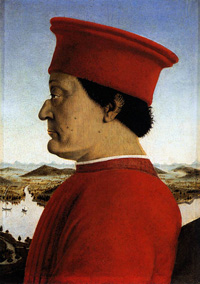
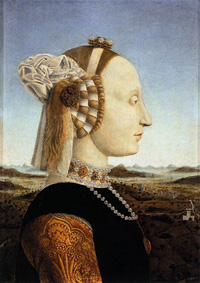
Diptych Portrait of Federico da Montefeltro and Battista Sforza
|
The Aragonese Kings of Naples
|
The Kingdom of Naples was ruled by the royal House of Aragon (between 1442 - 1501), denoted in Italy by the surname d'Aragona. The royal family derives from the House of Trastamara, the ruling family of Aragon, Castle, and Leon. The most famous members are the Catholic Monarchs Ferdinand II of Aragon and Isabella I of Castile. They would battle France for possession of Naples during the Borgia period.
The Neapolitan House of Aragon derived from the first Aragonese king of Naples - Alfonso V "the Magnanimous." Known in Neapolitan monarch lists as Alfonso I of Aragon, he was also king of the "Crown" of Aragon, which included Aragon proper (roughly northeastern Spain) King of Aragon, Valencia, Majorca, Sardina, Corsica, and Sicily. He conquered Naples in 1442.
Alfonso's Spanish lands were ruled by his brother John II of Aragon, which were later willed to him. When Alfonso died, his illegitimate son Ferdinand I/ Ferrante - pictured above at above right received Naples and Sicily. Ferrante ruled Naples long and with a firm hand against numerous baronial uprisings, clashes with the papacy, and threat of French invasion. His son Alfonso II of Naples (Duke of Calabria), pictured at right, succeeded him as King of Naples in 1494. he ruled for one year before abdicating and leaving the throne to his young son Ferdinand II of Naples (Ferrantino).
Ferdinand II of Aragon (King of Spain) and Ferrante I (King of Naples) were cousins - Ferdinand's father was John II of Aragon, and Ferrante's father was Alfonso V the Magnanimous.
|
The Orsini Family |
The Orsini Family is one of the most celebrated princely families in Medieval Italy and Renaissance Rome. The family has a number of popes (Celestine III, Nicholas III, and Benedict XIII), thirty-four cardinals, and scores of condottieri. One of the most famous was Gentile Virginio Orsini, head of the Bracciano branch of the family.
The Orsini were traditional enemies of the Colonna family, who also produced numerous popes, cardinals, and condottieri. The Orsini owned mnay fine and well-fortified castles in Lazio and around Rome. The biggest is Bracciano (on Lake Bracciano outside of Rome), Avezzano (Abruzzi), Nerola (near Rome), Sant'Angelo Romano (near Rome), Soriano nel Cimino (Viterbo), and Vasanello (Viterbo).
The Orsini married into nearly every noble house in central and southern Italy. For example, Lorenzo de Medici was married to a Roman Orsini (of the Monterotondo line) to enhance his family's prestige (they were considered upstarts); she brought an enormous dowry to Florence. Cardinal Giovanni Battista Orsini was also of this line. The Orsini were closely alligned with the Kingdom of Naples, and were powerful feudal lords "barons" in and around Naples as well as Rome. Taranto was a seat of Orsini power when it was given to the southern line of the family after the defeat of Queen Joanna II of Naples.
|
The Colonna Family
|
The Colonna family was a powerful noble papal family (Guelph) of Medieval Italy and Renaissance Rome, supplying one pope and many other leaders. Their family is notable for their bitter feud with the Orsini (above) family over influence in Rome until it was stopped by Papal Bull in 1511.
In 1297 the Colonna family, who had owned Praeneste (by then called Palestrina) from the eleventh century as a fief, revolted from the pope. In the following year the town was taken by Papal forces, razed to the ground and salted by order of Pope Boniface VIII. In 1437 the rebuilt city was captured by the Papal general Giovanni Vitelleschi and once more utterly destroyed at the command of Pope Eugenius IV.
It was rebuilt once more and fortified by Stefano Colonna in 1448. It was again sacked in 1527, and occupied by the Duke of Alba, in 1556.
Prospero, who had joined Cardinal Giluiano della Rovere's party, was imprisoned in Castel Sant'Angelo by Pope Alexander VI. Once freed, he was soon imprisoned again for his allegiance to Charles VIII of France during his invasion of Italy in 1494. Prospero Colonna had an important role in the Spanish victory at Cerignola (1503), which gave Spain the keys to Naples. After Alexander VI's death, he was also able to take back his territories in the Lazio.
Other important members of the Colonna family are famous noblewoman and poet Vittoria Colonna, (friend of Michelangelo), Marcantonio and Fabrizio Colonna (successful condottieri).
|
The Bentivoglio Family of Bologna
|
The Bentivoglio ruled the important Romagna city and environs of Bologna from 1401 until 1506. They were a princely family allegedly descended from Holy Roman Emperor Frederick II (through one of his illegitimate sons - Enzio, King of Sicily). During the Guelph and Ghibelline conflicts (14th century) they overthrew rival factions for control of the city with the helkp of heir powerful allies, the Visconti. The Bentivoglio held power on and off for the next twenty-five years when finally the family received the fief of Castel Bolognese, a fortified city not far from Bologna.
Giovanni II at right ruled with his strong-willed wife Ginevra Sforza. Together they had eleven children and married many of them into the nobility of Central Italy.
Giovanni I, who ruled from 1401 to 1402.
Annibale I, murdered in 1443.
Sante I (1426-1463); ruled from 1443-1463.
Giovanni II (1443-1508); ruled from 1463 until he was expelled by Pope Julius II in 1506.
Annibale II reentered the city in 1511 with the help of the French and ruled for a year, and was later assassinated.
|
The Baglioni Family of Perugia
|
The Baglioni were successful and wealthy condottieri who exercise rule over the city of Perugia from the 1420s. Gian Paolo Baglioni (1470-1520) fought againstCesare Borgia on behalf of the Varano family in an attempt to regain Camerino in 1500. After contracting withVenice then the pope, In 1520 he was accused of an attempted assassination in Rome. Baglioni was imprisoned in Castel Sant'Angelo and beheaded.
The Baglioni had always fought with the Oddi family for the rule of Perugia in the region of Umbria. They rose to power in the 13th century. They amassed a fortune from the money earned from their condottieri ventures. Each Baglioni had their own palaces in the best part of town and built towers to show off their wealth. Murders, violence and rivalry as commonplace under Baglioni rule, either with the challenging Oddi family or with each other. They massacred the family in 1482 and 1484.
In 1500, at a wedding celebration, half of the Baglioni killed the other half. It was called the Red Wedding and now is what the Baglioni is famous for. The massacre caused many acts of vengeance within the Baglioni family. Gian Paolo Baglioni served under Cesare Borgia as a condottieri. He was one of those generals not killed at Senigallia by Cesare. Later he fought for the great powers of Italy, including Pope Julius II, Venice. They fell from power in the 17th century, selling their power and titles.
|
The House of Malatesta
|
The House of Malatesta was an Italian family that ruled Rimini from 1295 until 1500, as well as (in different periods) other lands and towns in Romagna. Malatesta da Veruccio (d. 1312), a Guelph leader, became podestà (chief magistrate) of Rimini in 1239 and made himself sole master of the city after the expulsion of the family's Ghibelline rivals, the Parcitadi, in 1295.
His hunchback son Giovanni Malatesta is chiefly famous because of the 1285 tragedy, recorded in Dante's Inferno, when he killed his wife Francesca da Polenta and his younger brother Paolo, having discovered them in adultery.
In the fourteenth and fifteenth centuries, the Malatesta ruled over a number of papal cities in the Romagna and the Marche, including Pesaro, Fano, Cesena, Fossombrone and Cervia.
Several Malatesta were condottieri at the service of various Italian states. The most famous was Sigismondo Pandolfo Malatesta (above right), who was engaged in conflict with the papacy over territorial claims. His grandson Pandolfo (lower right) took part in the Battle of Fornovo, and later besieged the French garrison at Novara. Pandolfo's violence and murders gained him the hatred of his subjects: in 1497, a failed rape attempt on a young girl spurred a revolt in Rimini, which he could suppress only with Venetian intervention. He escaped another plot in 1498.Two years later,Cesare Borgia invaded Pandolfo's territories and Pope Alexander VI, Cesare's father, excommunicated him. Rimini was finally incorporated in thePapal States in 1528, after the last failed attempt of Pandolfo's son, Sigismondo.
Piero della Francesca moved to Ferrara where he found a stimulating environment at the Court which was a model of humanist culture. He met the humanist Guarino da Verona and was allowed to study the gems and coins collected by Duke Lionello At that time there was a painting by Rogier Van der Weyden in Ferrara. This allowed Piero to observe the great Flemish artist’s eye for detail and his command of oil painting.
In 1451, Piero left Ferrara for Rimini, which was under the rule of the Malatesta and where he was commissioned to paint the votive fresco of Sigismondo Pandolfo Malatesta in Tempio Malatestiano. In Rimini, Piero took part in the humanist restoration of the Tempio conceived by Leon Battista Alberti, who, besides leaving important architectural masterpieces in Florence, deeply affected the Courts of Mantua and Urbino.
Shortly after completing the fresco in Rimini, he worked on the cycle The Legend of the True Cross in San Francesco in Arezzo, which was started after 1452.
Art in Tuscany |
Art in Tuscany | Piero della Francesca, Portrait of Sigismondo Pandolfo Malatesta
|
|
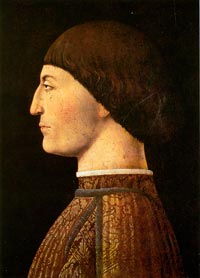
Piero della Francesca, Portrait of Sigismondo Pandolfo Malatesta, Prince of Rimini (c.1451) Musée du Louvre, Paris |
The Petrucci Family of Siena
|
Antonio Petrucci led an unsuccessful attempt to seize power from the republican government in 1456. He was forced into exile as a result of the failed coup. The remaining family gradually reinforced their land and wealth, and by the 1480s had considerable influence in Siena once again.
Pandolfo Petrucci, called "il Magnifico" for his extensive patronage of the arts, foundations, and grand civic and religious building projects in Siena. He took power in 1487 by means of a gradual series of civil and military coups. He married Agnese Borghese, daughter of a prominent and wealthy member of the oligarchy. He assumed public offices, and appointed members of his faction to others. Most importantly he had the support of the armed city guard, as their captain he also became the protector of the populace.
Cesare Borgia was intent on eliminating the Petrucci, as they were the main obstacle to the conquest of Siena. After the fall of Urbino (July 1502) it seemed to Cesare's captains that the next action of the Borgia would have been against Perugia and then against Siena and Bologna. The growing fear of Cesare's power and the double dealing of his condottieri (who feared cesare would overrun their cities as well) led to the so-called Maggione Conspiracy, from the name of the castle of Giambattista Orisini, whose aim was to eliminate il Valentino. By not appearing personally at the conference at La Maggione, Pandolfo Petrucci (being more astute and foresaw the affects of the conspiracy) escaped the clutches of the Borgia and maintained his rule at Perugia.
|
| |
This page also uses material from the Wikipedia article Italian Renaissance published under the GNU Free Documentation License.
Pazzi conspiracy | Encyclopædia Britannica. Encyclopædia Britannica Online. Encyclopædia Britannica, 2011. Web. 21 Mar. 2011. |
|
|
![]()

